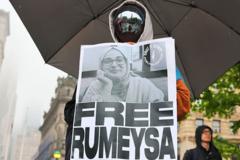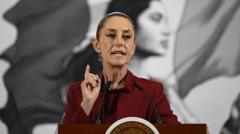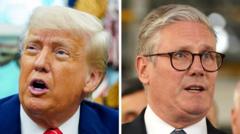With Canadians heading to the polls, the election takes on added significance due to shifting party dynamics and U.S. President Trump's influence on Canadian politics. Prime Minister Mark Carney, inheriting a turbulent political environment, faces off against Conservative leader Pierre Poilievre, as issues like the economy and immigration come to the forefront.
Canada Faces Crucial Election Amid Trump-Tariff Turmoil

Canada Faces Crucial Election Amid Trump-Tariff Turmoil
Polls are set to open for a pivotal election as Canada grapples with the fallout of President Trump’s trade war and an evolving political landscape.
Canadians are heading to the polls today for a crucial election that will shape the future of their country. As the country grapples with President Trump’s trade war and the resignation of former Prime Minister Justin Trudeau, voters are weighing their choices on significant issues concerning economic stability, national security, and immigration policy.
Polls opened in a staggered manner across Canada’s six time zones, with the majority closing at 9:30 p.m. Eastern Time. Early voter turnout was notably higher than in the last federal election, with approximately 7.3 million Canadians casting their ballots in the early voting period.
Currently, opinion surveys show the Liberal Party, led by new Prime Minister Mark Carney, holding a slight edge over the Conservative Party, led by Pierre Poilievre. Just months ago, the Conservatives led by a significant margin but have lost ground as public sentiment shifts in response to Trump’s aggressive tariffs and his rhetoric regarding Canadian sovereignty.
Three additional parties are vying for attention in this election, with the left-wing New Democratic Party, the Greens, and the Bloc Québécois providing alternative options for Canadian voters. The elections are seen as pivotal, with the leaders at the forefront offering differing visions for Canada at a time of political uncertainty.
Mark Carney, a former central banker celebrated for his economic acumen, has positioned himself as the candidate best equipped to counter Trump’s challenges. Conversely, Poilievre’s close ideological ties with Trump and focus on deregulation and a reduced federal presence have garnered mixed reactions from the electorate.
In the lead-up to the election, concerns over soaring housing costs and economic issues have eclipsed previously dominant immigration discussions. While Trudeau’s government once supported high immigration levels to meet labor demands, shifts in public opinion reflecting growing stresses on social services have transformed immigration into a lower priority in voters' minds.
The election is also crucial for Quebec, as the Bloc Québécois aims to secure representation for the province at a time of heightened national tensions. Once polling strongly against the Liberals, the Bloc’s fortunes have waned, partly due to the perception that Quebec’s cultural survival may depend on remaining within Canada amidst Trump’s threats.
Other notable moments leading to this election have included remarks by Trump, who reiterated his desire to absorb Canada into the United States. This has led to backlash from both major parties, with leaders emphasizing Canadian sovereignty and the centrality of the upcoming election in determining the nation’s future.
As ballots are counted late Monday night, all eyes will be on the outcomes in key riding districts, where shifting support could signal significant changes in the parliamentary balance. Voter turnout and sentiment could usher in a new chapter for Canada’s political landscape amid the global turmoil sparked by the Trump administration.






















